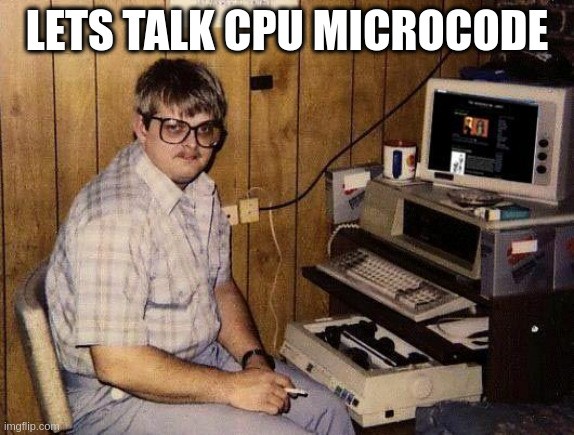
All about CPU microcode
If you have used a Linux system, you would inevitably stumble upon the amd-ucode or the intel-ucode packages (that's what they are called on Arch). These are microcode updates for your CPU. To understand what are CPU microcodes, let's take a dive into the history of CPU designing.

Microcode is a layer of programming that resides within the control unit of a CPU. It acts as an intermediary between machine-level instructions and the hardware components of the processor. Unlike traditional software, microcode is stored in a special area of the CPU called control memory or control store. It consists of a sequence of microinstructions, each corresponding to a fundamental operation that the CPU can perform.

The origins of CPU microcode can be traced back to the mid-20th century when computers were transitioning from being specialized machines to more general-purpose devices. In 1951, Maurice Wilkes, a pioneer in computer architecture, introduced the concept of microprogramming at the University of Cambridge. Microprogramming marked a departure from the rigid, hardwired control units of early computers.

During this era, computers were physically rewired to execute specific instructions, making them inflexible and cumbersome to adapt to evolving computing needs. Wilkes proposed a novel approach - replacing hardwired control with a set of simpler instructions stored in memory. These instructions, known as microinstructions, would be interpreted by a control unit, providing a more agile and versatile method of handling instructions.
Later in the 1960s and 1970s, the concept of microcode found its way into mainframe and minicomputer architectures. IBM's System/360, introduced in 1964, was a pioneering system that embraced microcode to achieve compatibility across various models. Microcode allowed IBM to maintain a consistent interface while evolving the underlying hardware.
During this period, minicomputer manufacturers like DEC (Digital Equipment Corporation) also adopted microcode to enhance the functionality of their machines. Microcode became instrumental in managing the growing complexity of instruction sets and facilitating compatibility across different models within a product line.
The advent of microprocessors in the 1970s brought about a significant shift in computing. As entire CPUs were integrated onto a single chip, the importance of microcode became more pronounced. Microprocessors like the Intel 8086 and Motorola 68000 utilized microcode to provide a versatile and programmable architecture, enabling compatibility with a wide range of software.
With the proliferation of personal computers in the 1980s, microcode played a pivotal role in supporting diverse operating systems and applications. Microcode allowed manufacturers to address bugs, optimize performance, and introduce new features through firmware updates, avoiding the need for costly hardware modifications.
In modern x86 architectures, CPU microcode plays a crucial role in bridging the gap between the high-level x86 machine instructions that software developers write and the intricate hardware of the processor. At the heart of this architecture lies a complex instruction set computing (CISC) design, where each x86 instruction can correspond to a series of microinstructions. These microinstructions are stored in a special memory area within the CPU known as the control store.
When the CPU receives an x86 instruction from the program being executed, the microcode steps in to decode this instruction. The microcode translates the x86 instruction into a sequence of microinstructions, which are the elementary operations that the CPU's control unit can execute. These microinstructions control various aspects of the processor, such as fetching data from registers or memory, performing arithmetic or logical operations, and managing control signals to coordinate the flow of data within the CPU.
The flexibility of microcode is particularly evident in modern x86 processors. Despite the standardized x86 instruction set, different CPU models from various manufacturers may implement microcode differently to optimize performance and power efficiency. Microcode allows for firmware updates, which are crucial for addressing bugs, improving performance, or introducing support for new instructions without requiring changes to the physical hardware.
In addition to its role in instruction decoding and control unit management, microcode is vital for handling complex instructions efficiently. Many x86 instructions have variable-length formats and can perform a multitude of operations. Microcode breaks down these complex instructions into smaller, manageable steps, allowing the CPU to execute them with precision and speed.

The execution of microinstructions is often pipelined, allowing the CPU to process multiple instructions simultaneously. Each stage of the pipeline corresponds to a set of microinstructions, contributing to the overall efficiency of instruction execution. Microcode also plays a crucial role in handling exceptions and interrupts, ensuring that the CPU responds appropriately to unexpected events during program execution.
Microinstructions may seem like microscopic details in the grand architecture of a CPU, but their meticulous execution is what breathes life into the machine. As CPUs become more sophisticated, the role of microinstructions becomes even more critical, allowing for the fine-tuning of operations and the optimization of performance in the ever-evolving landscape of computing.
Some resources
Arch Wiki - https://wiki.archlinux.org/title/microcode
Some forum that somehow explains it very well - https://superuser.com/questions/1283788/what-exactly-is-microcode-and-how-does-it-differ-from-firmware